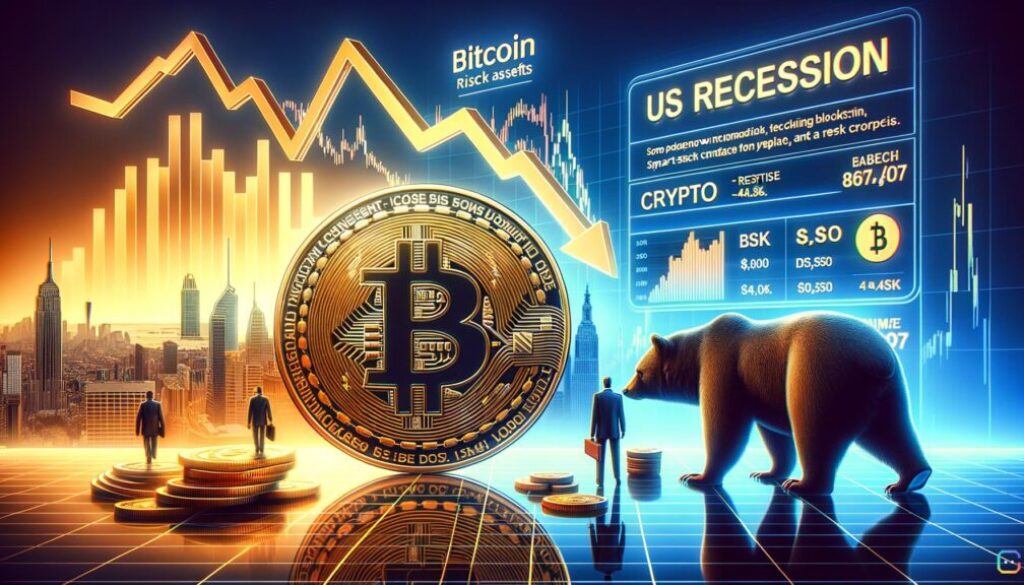Bitcoin and Risk Assets Poised to Benefit from US Recession Predictions

Economic Crossroads: Recession Fears and the Fed’s Next Move
The global financial landscape is buzzing with speculation. Bitcoin traders and investors across asset classes are keenly observing signals of potential shifts in US economic policy. Mounting economic data is putting significant pressure on the Federal Reserve, with increasing talk of a looming US recession fueled by rising unemployment figures and stubborn inflation.
In this complex environment, a fascinating narrative is emerging: could an economic downturn actually be beneficial for Bitcoin and other risk assets? Let’s explore the dynamics at play.
Warning Signs: Is a US Recession on the Horizon?
Several indicators suggest the US economy might be heading for choppier waters:
- Rising Unemployment: An uptick in joblessness can signal weakening economic activity and reduced consumer spending.
- Resurging Inflation: While the Fed has aggressively hiked rates to combat inflation, persistent price pressures remain a challenge, complicating policy decisions.
- Challenging Economic Data: Recent reports, including GDP figures, have pointed towards a potential slowdown or negative trend, increasing concerns about economic health.
- External Pressures: Factors like global trade tariffs continue to add layers of uncertainty to the economic outlook.
These converging factors create a difficult scenario for policymakers, particularly the Federal Reserve.
The Federal Reserve’s Tightrope Walk
The Fed finds itself in a precarious position. Its primary mandate involves maintaining price stability (controlling inflation) and maximizing employment. Historically, the central bank raises interest rates to cool down an overheating economy and curb inflation. Conversely, it cuts rates to stimulate growth during downturns.
However, the current situation presents a dilemma: fight persistent inflation with high rates, potentially deepening an economic slowdown, or cut rates to support growth, risking further inflation? The latest economic data is forcing the Fed to reconsider its stance, with market participants eagerly anticipating potential policy shifts, especially regarding interest rates, in upcoming Federal Open Market Committee (FOMC) meetings.
Why an Economic Slowdown Could Boost Bitcoin
While counterintuitive, some prominent voices in the financial world suggest a US recession could serve as a significant catalyst for Bitcoin. How?
The expectation hinges on the Federal Reserve’s likely response to a confirmed recession: interest rate cuts. Lowering interest rates typically aims to:
- Reduce borrowing costs for businesses and consumers.
- Encourage spending and investment.
- Increase overall liquidity in the financial system.
Historically, increased liquidity and a lower-rate environment tend to benefit risk assets – investments perceived to have higher risk but also higher potential returns. This category often includes stocks and, increasingly, cryptocurrencies like Bitcoin. Some large institutional investors reportedly view potential market corrections driven by economic headwinds not as a deterrent, but as strategic buying opportunities for assets like Bitcoin.
Bitcoin: Navigating the Risk Asset vs. Safe Haven Debate
Bitcoin’s role during economic uncertainty is often debated. Does it act as a ‘digital gold’ – a safe haven asset – or does it behave more like a traditional risk asset?
Arguments for Safe Haven Potential:
- Fixed Supply: Unlike fiat currencies, Bitcoin has a capped supply (21 million coins), potentially protecting it from inflationary devaluation.
- Decentralization: Its network operates outside the control of central banks and governments.
Arguments for Risk Asset Behavior:
- Market Correlation: Historically, Bitcoin’s price has often moved in tandem with equity markets, particularly during broad market selloffs. This correlation challenges its status as a reliable defensive asset when traditional markets tumble.
- Sensitivity to Monetary Policy: Bitcoin’s price is heavily influenced by market sentiment and liquidity conditions, which are directly impacted by Fed decisions. Rising interest rates tend to make lower-risk assets (like bonds or high-yield savings accounts) more attractive, potentially drawing capital away from Bitcoin. Conversely, rate cuts can increase appetite for risk-on assets.
Therefore, while Bitcoin possesses some unique characteristics, its price action, especially in response to macroeconomic shifts and Fed policy, often aligns it with other risk assets.
The Potential Impact of Rate Cuts
If recession fears compel the Fed to pivot towards easing monetary policy and cutting interest rates, many analysts anticipate a positive impact on Bitcoin. Lower rates could inject liquidity into the market, potentially driving investors towards assets with higher growth potential as the opportunity cost of holding cash or low-yield bonds increases. This influx of capital could fuel demand and push Bitcoin prices higher.
Navigating the Uncertainty
The relationship between economic downturns, Fed policy, and Bitcoin’s price is complex and influenced by numerous factors. While the prospect of rate cuts driven by a potential recession offers a bullish narrative for Bitcoin and risk assets, the economic outlook remains uncertain. Trade tensions, geopolitical events, and the unpredictable nature of inflation can all impact market dynamics.
As the situation evolves, market participants will continue to scrutinize economic data releases and communications from the Federal Reserve. The anticipation surrounding the Fed’s next move highlights the significant influence of macroeconomic factors on the cryptocurrency markets.
While the potential for Bitcoin to benefit from recession-driven policy changes is compelling, it’s crucial for investors to stay informed and conduct thorough research before making any investment decisions in this volatile market.


